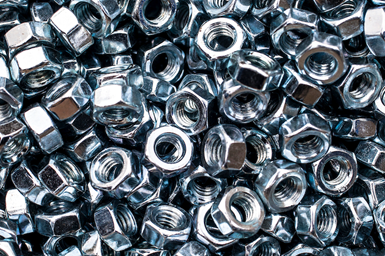Troubleshooting Alkaline Zinc
One of the most common problems that can arise when plating with alkaline zinc is an imbalance of brightener in the solution. In this helpful Ask the Expert article, Chad Murphy of Columbia Chemical discusses how different zinc metal concentrations and brightener concentrations can impact efficiency.

Q. We have operated two large rack plating lines with alkaline zinc for 15 years with very few problems. However, now we are experiencing trouble with extremely slow plating speeds, poor LCD coverage and overall appearance (dull with striations). We have made zero operational or staffing changes on our end, yet we are experiencing major defects due to these issues. What could cause these problems to suddenly occur?
A. One of the most common problems when troubleshooting alkaline zinc is an imbalance of brightener in the solution. Since you are well versed in alkaline zinc plating, we can presume you are analyzing your bath at least weekly for the levels of zinc and caustic as well as running hull cell panels to check the plating thickness and ratio. As an operational rule of thumb, your zinc metal should be between 1.5-2.0 ounces/gallon, your caustic soda should be around 16 ounces/gallon (slightly higher for barrel plating), and carbonates should be less than 12 ounces/gallon. What is important to note is that even if your numbers come back in range after analysis, the thickness on your hull cell panels can reveal potential problems. When you run a 2amp 30-minute panel, your thickness should be around 0.5 mils for the 80 ASF and 0.25 mils for the 4 ASF. Anything below that can indicate a potential brightener imbalance and should be addressed.
It’s important to understand how different zinc metal concentrations and brightener concentrations can impact efficiency. There is a direct correlation between the amount of a brightener in the zinc plating solution and the overall efficiency of the solution. Follow your chemical suppliers’ recommendations for the proper amount of brightener by volume to achieve maximum efficiency. When you scale up the brightener, while it may help brightness in some instances and help distribution in others, it will also slow down your solution. This is because as you increase the brightener, you’re also increasing interferences to the plating deposition rate, which in turn affects the efficiency, especially in the high current density areas: the more brightener, the lower the efficiency. Therefore, when there is a brightener overload, you can see slower plating speeds in the high (and even in the low) current density areas. It is common to see efficiency levels down below 50% when there is a major overload of brightener.
Proper management of an alkaline zinc bath also requires understanding the effects of zinc metal on solution efficiency. The higher the zinc metal, the higher the efficiency. One way you can get out of a slight brightener overload is by increasing the zinc metal to overcome the high amounts of brightener in the solution. However, there’s a limited amount of return on that gain in metal, so be aware that anything above 2.0 ounces/gallon will result in a very minimal gain in efficiency. When it falls right at 2.0 ounces/gallon is where you will find the highest amount of efficiency and plating speed with the best gain in brightener usage. Any time you have a low zinc metal concentration (around one ounce/gallon) your efficiency will be extremely low. Your ideal range is between 1.5 ounces per gallon and 2.0 ounces per gallon on the zinc metal for maximum efficiency.
It is an extremely common belief that if a little brightener helps, then more will really help, when instead this creates a bad combination and a downward spiral. If you determine you have an overload of brightener, the quickest way to fix the problem is an addition of 1% of sodium hypochlorite industrial grade. After treatment with hypochlorite and good filtration, you should see your solution return to a nice clear color and provide better plating outcomes. You will want to work with your supplier to analyze the solution and determine if you need a small amount of proprietary booster and to ensure you have fully removed all the additional brightener from the solution. Automated amp-hour feeders are an important tool to help maintain proper additions, eliminate wasted product, and keep your bath in check. Be sure to check the flow rates of the feed pumps regularly and ensure the amp-hours are accumulating properly to minimize any issues.
Once you get to the root cause of your problem and things are back on track, be sure to maintain a regular schedule of analyzing your bath weekly to ensure the operating parameters are in the optimum range, routinely run hull cell panels to check for appearance and thickness and take action if the thickness drops out of the target range, whether that’s adjusting the zinc metal concentration, treating with hypochlorite, filtration or addressing the carbonate levels. Eliminating the margin for error with automated feeder pumps and careful attention to overall process monitoring and control should help keep your costs down, save time and decrease rejects. In addition, lean on your trusted chemistry supplier as they should be more than willing to spend time educating your operators on the properties of each additive within the solution and how they work together for maximum efficiency.
About the Author

Chad Murphy
Chad Murphy is a Technical Account Manager for Columbia Chemical. Visit columbiachemical.com.
Related Content
Nanotechnology Start-up Develops Gold Plating Replacement
Ag-Nano System LLC introduces a new method of electroplating based on golden silver nanoparticles aimed at replacing gold plating used in electrical circuits.
Read MoreProducts Finishing Reveals 2023 Qualifying Top Shops
Each year PF conducts its Top Shops Benchmarking Survey, offering shops a tool to better understand their overall performance in the industry. The program also recognizes shops that meet a set of criteria to qualify as Top Shops.
Read MoreInnovation in Plating on Plastic
Plating on advanced plastics solution offers improved adhesion, temperature resistance and cost savings.
Read MoreAn Overview of Electroless Nickel Plating
By definition, electroless plating is metal deposition by a controlled chemical reaction.
Read MoreRead Next
Family-owned Zinc Plater Looks to the Future
Creative solutions and a willingness to take on challenges is at the heart of Grand Rapids-based finisher’s success.
Read MoreZinc - An Important Nutrient
Once again, long-time AESF/NASF contributor Jack Dini provides another of his highly regarded and fascinating writings, this time on the benefits of zinc.
Read More













.jpg;maxWidth=300;quality=90)







